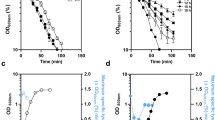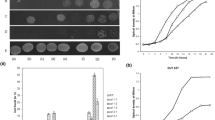Abstract
The yeast Candida maltosa is a model organism for studying adaptive changes in the structure and function of the cell wall when consuming water-insoluble nutrient sources. The cells of C. maltosa that utilize hydrocarbons contain supramolecular structures, so-called “canals” in the cell wall. Differences in protein profiles of culture liquids and cell wall extracts of C. maltosa grown on glucose and hexadecane were analyzed. Three proteins specific of cells grown on hexadecane were revealed using mass spectrometry: glycosyl hydrolase EPD2 in the culture liquid; a protein belonging to the cytochrome C family in the 0.5 mol/L NaCl extract; and PPIA_CANAL protein known as chaperone, in the 0.1% SDS extract. The possible role of these proteins in cell wall structures responsible for adaptation to hexadecane utilization is discussed.




Similar content being viewed by others
References
Beier A, Hahn V, Bornscheuer UT, Schauer F (2014) Metabolism of alkenes and ketones by Candida maltosa and related yeasts. AMB Express 4, eCollection 2014. https://doi.org/10.1186/s13568-014-0075-2
Davì V, Chevalier L, Guo H, Tanimoto H, Barrett K, Couturier E, Boudaoud A, Minc N (2019) Systematic mapping of cell wall mechanics in the regulation of cell morphogenesis. Proc Natl Acad Sci U S A116(28):13833–13838. https://doi.org/10.1073/pnas.1820455116
Dižová S, Černáková L, Bujdáková H (2018) The impact of farnesol in combination with fluconazole on Candida albicans biofilm: regulation of ERG20, ERG9, and ERG11 genes. Folia Microbiol 63:363–337. https://doi.org/10.1007/s12223-017-0574-z
Dmitriev VV, Crowley DE, Rogachevsky VV, Negri CM, Rusakova TG, Kolesnikova SA, Akhmetov LI (2011) Microorganisms form exocellular structures, trophosomes, to facilitate biodegradation of oil in aqueous media. FEMS Microbiol Lett 315:134–140
Dmitriev VV, Crowley DE, Zvonarev AN, Rusakova TG, Negri CM, Kolesnikova SA (2016) Modifications of the cell wall of yeasts grown on hexadecane and under starvation conditions. Yeast 33:55–62
Finogenova TV, Morgunov IG, Kamzolova SV, Chernyavskaya OG (2005) Organic acid production by the yeast Yarrowia lipolytica: a review of prospects. Appl Biochem Microbiol 41:418–425
Fukuda R (2013) Metabolism of hydrophobic carbon sources and regulation of it in n-alkane-assimilating yeast Yarrowia lipolytica. Biosci Biotechnol Biochem 77:1149–1154
Fukuda R, Ohta A (2017) Genetic features and regulation of n-alkane metabolism in yeasts. In: Rojo F (ed) Aerobic utilization of hydrocarbons, oils and lipids. Handbook of hydrocarbon and lipid microbiology. Springer, Cham
Galat A (2003) Peptidylprolyl cis/trans isomerases (immunophilins): biological diversity-targets functions. Curr Top Med Chem 3:1315–1347
Garcia-Rubio R, de Oliveira HC, Rivera J, Trevijano-Contador N (2020) The fungal cell wall: Candida, Cryptococcus, and Aspergillus species. Front Microbiol 10:2993. https://doi.org/10.3389/fmicb.2019.02993 eCollection 2019
Hirai K (1971) Comparison between 3,3'-diaminobenzidine and auto-oxidized 3,3 '-diaminobenzidine in the cytochemical demonstration of oxidative enzymes. J Histochem Cytochem 19:434–442
Huang C, Zhao F, Lin Y, Zheng S, Liang S, Han S (2018) RNA-Seq analysis of global transcriptomic changes suggests a roles for the MAPK pathway and carbon metabolism in cell wall maintenance in a Saccharomyces cerevisiae FKS1 mutant. Biochem Biophys Res Commun 500:603–608
Iwama R, Kobayashi S, Ishimaru C, Ohta A, Horiuchi H, Fukuda R (2016) Functional roles and substrate specificities of twelve cytochromes P450 belonging to CYP52 family in n-alkane assimilating yeast Yarrowia lipolytica. Fungal Genet Biol 91:43–54
Kawamoto S, Tanaka A, Yamamura M, Teranishi Y, Fukui S (1977) Microbody of n-alkane-grown yeast. Arch. Microbiol. 112(1977):1–8
Kelly SL, Kelly DE (2013) Microbial cytochromes P450: biodiversity and biotechnology. Where do cytochromes P450 come from, what do they do and what can they do for us? Phil Trans R Soc B 368. https://doi.org/10.1098/rstb.2012.0476
Klis FM, de Jong M, Brul S, de Groot PW (2007) Extraction of cell surface associated proteins from living yeast cells. Yeast 24:253–258
Kogure T, Horiuchi H, Matsuda H, Arie M, Takagi M, Ohta A (2007) Enhanced induction of cytochromes P450alk that oxidize methyl-ends of n-alkanes and fatty acids in the long-chain dicarboxylic acid-hyperproducing mutant of Candida maltosa. FEMS Microbiol Lett 271:106–111
Kogure T, Takagi M, Ohta A (2005) n-Alkane and clofibrate, a peroxisome proliferator, activate transcription of ALK2 gene encoding cytochrome P450alk2 through distinct cis-acting promoter elements in Candida maltosa. Biochem Biophys Res Commun 329:78–86
Laemmli UK (1970) Cleavage of structural proteins during the assembly of the head of bacteriophage T4. Nature 227:680–685
Liu ZL, Wang X, Weber SA (2018) Tolerant industrial yeast Saccharomyces cerevisiae possess a more robust cell wall integrity signaling pathway against 2-furaldehyde and 5-(hydroxymethyl)-2-furaldehyde. J Biotechnol 276–277:15–24
Mauersberger S, Kärgel E, Matyashova RN, Müller HG (1987) Subcellular organization of alkane oxidation in the yeast Candida maltosa. J Basic Microbiol 27:565–582
Mauersberger S, Ohkuma M, Schunck WH, Takagi M (1996) Candida maltosa. In: Wolf K (ed) Nonconventional Yeasts in Biotechnology. Springer, Berlin, pp 411–580
Molon M, Woznicka O, Zebrowski J (2018) Cell wall biosynthesis impairment affects the budding lifespan of the Saccharomyces cerevisiae yeast. Biogerontology 19:67–79
Mori K, Iwama R, Kobayashi S, Horiuchi H, Fukuda R, Ohta A (2013) Transcriptional repression by glycerol of genes involved in the assimilation of n-alkanes and fatty acids in yeast Yarrowia lipolytica. FEMS Yeast Res 13:233–240
Nakazawa T, Takahashi M, Horiuchi H, Ohta A, Takagi M (2000) Cloning and characterization of EPD2, a gene required for efficient pseudohyphal formation of a dimorphic yeast, Candida maltosa. Biosci Biotechnol Biochem 64:369–377
Ohkuma M, Muraoka SI, Tanimoto T, Fujii M, Ohta A, Takagi M (1995) CYP52 (Cytochrome P450alk) multigene family in Candida maltosa: identification and characterization of eight members. DNA Cell Biol 14:163–173
Ohkuma M, Tanimoto T, Yano K, Takagi M (1991) CYP52 (Cytochrome P450alk) multigene family in Candida maltosa: molecular cloning and nucleotide sequence of the two tandemly arranged genes. DNA Cell Biol 10:271–282
Reynolds ES (1963) The use of lead citrate at high pH as an electron-opaque stain in electron microscopy. J Cell Biol 17:208–212
Sabirzyanov FA, Sabirzyanova TA, Rekstina VV, Adzhubei AA, Kalebina TS (2018) C-Terminal sequence is involved in the incorporation of Bgl2p glucanosyltransglycosylase in the cell wall of Saccharomyces cerevisiae. FEMS Yeast Res 18. https://doi.org/10.1093/femsyr/fox093
Sanz AB, García R, Rodríguez-Peña JM, Arroyo J (2017) The CWI Pathway: regulation of the transcriptional adaptive response to cell wall stress in yeast. J Fungi 4. https://doi.org/10.3390/jof4010001
Schägger H, von Jagow G (1987) Tricine-sodium dodecyl sulfate-polyacrylamide gel electrophoresis for the separation of proteins in the range from 1 to 100 kDa. Anal Biochem 166:368–379
Schunck W-H, Kärgel E, Gross B, Wiedmann B, Mauersberger S, Köpke K, Kießling U, Strauss M, Gaestel MM, Müller H-G (1989) Molecular cloning and characterization of the primary structure of the alkane hydroxylating cytochrome P450 from the yeast Candida maltosa. Biochem Biophys Res Commun 161:843–850
Suchodolski J, Derkacz D, Muraszko J, Panek JJ, Jezierska A, Łukaszewicz M, Krasowska A (2020) Fluconazole and lipopeptide surfactin interplay during Candida albicans plasma membrane and cell wall remodeling increases fungal immune system exposure. Pharmaceutics 12(4):E314. https://doi.org/10.3390/pharmaceutics12040314
Takagi M, Ohkuma M, Kobayashi N, Watanabe W, Yano K (1989) Purification of cytochrome P-450alk from n-alkane-grown cells of Candida maltosa, and cloning and nucleotide sequencing of the encoding gene. Agric Biol Chem 53:2217–2226
Vogel F, Kargel E, Schunck W-H (1991) In situ localization of cytochrome P-450, the first enzyme involved in aliphatic hydrocarbon degradation in the yeast Candida maltose. Prog Histochem Cytochem 23:383–389
Willaert RG (2018) Adhesins of yeasts: protein structure and interactions. J Fungi (Basel) 4(4):E119. https://doi.org/10.3390/jof4040119
Yeh YC, Wang HY, Lan CY (2020) Candida albicans Aro1 affects cell wall integrity, biofilm formation and virulence. J Microbiol Immunol Infect 53(1):115–124. https://doi.org/10.1016/j.jmii.2018.04.002
Zvonarev AN, Crowley DE, Ryazanova LP, Lichko LP, Rusakova TG, Kulakovskaya TV, Dmitriev VV (2017) Cell wall canals formed upon growth of Candida maltosa in the presence of hexadecane are associated with polyphosphates. FEMS Yeast Res 17. https://doi.org/10.1093/femsyr/fox026
Acknowledgements
Electron Microscopy Core Facilities of the Pushchino Center of Biological Research (http://www.ckp-rf.ru/ckp/670266/)
Author information
Authors and Affiliations
Corresponding author
Additional information
Publisher’s note
Springer Nature remains neutral with regard to jurisdictional claims in published maps and institutional affiliations.
Rights and permissions
About this article
Cite this article
Zvonarev, A., Farofonova, V., Kulakovskaya, E. et al. Changes in cell wall structure and protein set in Candida maltosa grown on hexadecane. Folia Microbiol 66, 247–253 (2021). https://doi.org/10.1007/s12223-020-00840-2
Received:
Accepted:
Published:
Issue Date:
DOI: https://doi.org/10.1007/s12223-020-00840-2




